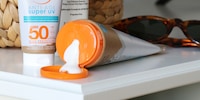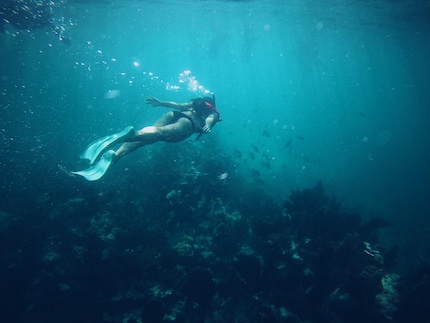
Background information
Don’t be blinded by the SPF
by Natalie Hemengül

Sun cream is a must at the seaside. Unfortunately, the ingredients it contains only protect our skin, not the oceans.
Many commercially available sun creams contain microplastics. This is undoubtedly bad for our oceans. However, two other additives have now become the focus of scientific and media attention: octinoxate and oxybenzone. Both substances are chemical UV filters and are supposed to protect our skin from dangerous UVA and UVB rays. However, studies show that these substances are bad for us and our environment.
Octinoxate is one of the most commonly used UV filters in the world. Although it has a low risk of skin irritation and is easily absorbed by the skin, it also has an oestrogenic effect on the body. Studies have also shown that exposure to the sun leads to the formation of free radicals, which damage DNA and can therefore lead to skin cancer.
Oxybenzone in turn converts the UV rays on the skin's surface from light into heat. This process can damage skin cells, trigger allergies and disrupt the hormone balance.
These UV filters cause entire coral reefs to bleach and die off. The chemical substances in the sunscreens are transferred from the skin into the sea through bathing, where they ultimately end up on the corals. This attacks and alters the coral's DNA. Ultimately, this leads to the death of entire reefs. The UV filters also disrupt the growth of phytoplankton - microscopic algae - which are an important part of the marine food chain.
According to the scientist Yousong Ding and the latest studies, around 14,000 tonnes of sunscreen end up in our oceans every year. This has fatal consequences for our coral reefs and all marine life. "These chemicals are now found everywhere in nature, from the Arctic to remote coral reefs in the South Pacific. They are found in dolphins, wild bird eggs, many of the fish we eat and in corals," says researcher Craig Downs from the Haereticus lab in Virginia.
The US National Oceanic and Atmospheric Administration (NOAA) has sounded the alarm, and to good effect. According to NOAA, around 6000 tonnes of sun cream end up in sensitive domestic waters every year. To name just one example: On the island of Maui, it's around 210 litres per day. "My prediction is that soon there will be no more living coral reefs in Hawaii for tourists to visit," says Craig Downs. "Hawaii, like the Florida Keys, will be a nice place to lie on the beach, but it will have lost its most precious natural resource and its biggest tourist attraction."

Hawaii has responded to the dramatic forecasts and recently became the first US state to ban the sale of sun creams containing the dangerous substances from 2021. In Mexico (Yucatán), too, only biodegradable sun cream is allowed on the beach. As environmental awareness grows, the beauty industry is slowly rethinking its approach. It is trying to develop products that do away with harmful UV filters and instead use natural minerals such as zinc oxide to combat the dangerous UV rays. Zinc oxide acts like a tiny mirror on the skin and protects it by reflecting sunlight. The alternative substances are also not entirely harmless to our environment, but only cause a fraction of the pollution caused by octinoxate and oxybenzone.
As an end consumer, it is really not easy to know whether you have chosen a good product. The jungle of sun creams seems endless and the composition of the individual substances is often kept a secret. The manufacturer Eco Cosmetics was one of the few sun creams to score "very good" in the latest ECO tests. It offers an alternative with mineral UV protection and is completely free from nanoplastics. The sun milk from Weleda and Lavera also dispenses with the harmful ingredients. [[product: 11222808, 9255859]]
Friends who live by the sea see the rapidly advancing
changes. The extinction of so many great sea creatures, the rubbish. We
can't wait any longer. It's clear that none of us can save the world tomorrow
can save the world tomorrow. But if we don't start changing just a small part of it every day
and think more about our consumption, the next generations,
perhaps even we, the sea, will
perhaps even us, will no longer be able to experience the sea as we know and love it.
So for your next visit to the blue water, make sure that your sun cream does not contain any microplastics or
chemical UV filters. Spread the word. Inform those around you. By doing so, you are making a big contribution to the change
to the change. Because we can actually stop this problem.
When I'm not distracted by a dog on the street because I'm dying to pet it and otherwise very much in love with animals and board sports, I try to understand, enjoy, question and always remain curious about the world around us. My camera is usually with me so that no story, daydream or moment goes to waste.
Interesting facts about products, behind-the-scenes looks at manufacturers and deep-dives on interesting people.
Show all